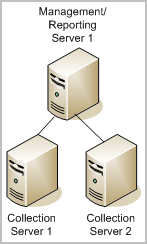

In the federation map shown in the diagram that follows, the network uses the management CA User Activity Reporting Module server as a reporting server and multiple collection servers in a configuration that is similar to an organization chart. The management/reporting server acts as a parent CA User Activity Reporting Module server and provides user authentication, authorization, and major management functions as well as the reporting functions of handling queries, reports and alerts. The collection servers in this example would be children of Management/Reporting Server 1. You could arrange additional levels in the hierarchy. However, there can be no more than one management server. Additional levels would be composed of reporting servers as parents to collection servers.
As an example of this style of federation, Management/Reporting Server 1 might be located at your headquarters office, with collection servers located in regional or branch offices represented by Collection Servers 1 and 2. Each branch could get reporting information on its own data, but not the data from the other branch. For example, from Collection Server 1, you can query and report on data only on Collection Server 1. From Management/Reporting Server 1, however, you can query and report on data from the Management/Reporting Server 1, Collection Server 1 and Collection Server 2.

In a hierarchical federation, each CA User Activity Reporting Module server can have one or more children, but only one parent. You configure this type of federation in a top-down fashion, starting with the management server. Then you move through each downward layer to configure the child reporting and collection servers. The key to configuring a federation is in first making a map of the servers and the intended relationships. Then you can configure a CA User Activity Reporting Module server as a child server, to implement the relationships between them.
|
Copyright © 2013 CA.
All rights reserved.
|
|